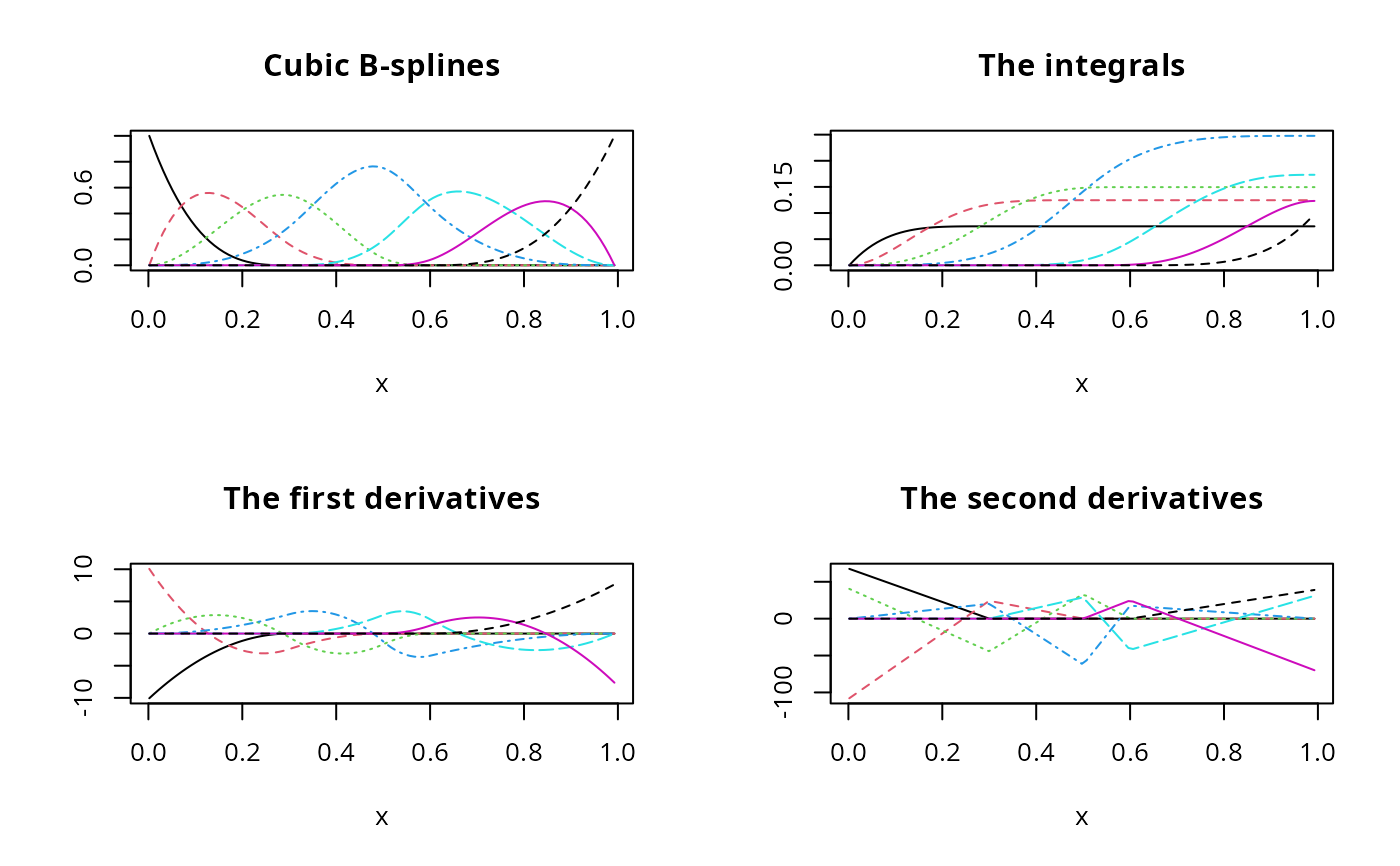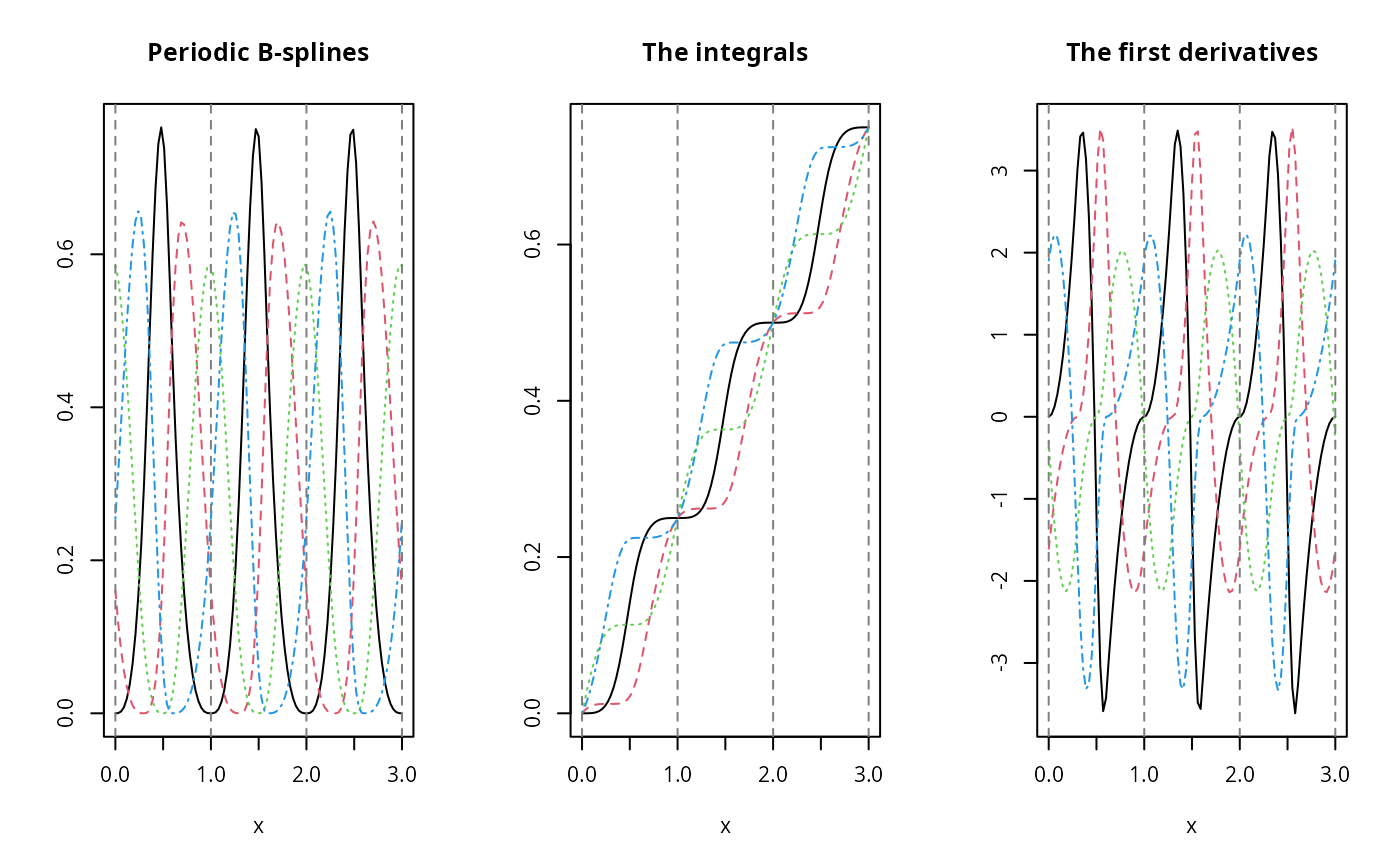Generates the spline basis matrix for B-splines representing the family of
piecewise polynomials with the specified interior knots, degree, and
boundary knots, evaluated at the values of x.
Usage
bSpline(
x,
df = NULL,
knots = NULL,
degree = 3L,
intercept = FALSE,
Boundary.knots = NULL,
periodic = FALSE,
derivs = 0L,
integral = FALSE,
warn.outside = getOption("splines2.warn.outside", TRUE),
...
)
ibs(
x,
df = NULL,
knots = NULL,
degree = 3,
intercept = FALSE,
Boundary.knots = NULL,
...
)
dbs(
x,
derivs = 1L,
df = NULL,
knots = NULL,
degree = 3,
intercept = FALSE,
Boundary.knots = NULL,
...
)
bsp(
x,
df = NULL,
knots = NULL,
degree = 3L,
intercept = FALSE,
Boundary.knots = NULL,
periodic = FALSE,
derivs = 0L,
integral = FALSE,
warn.outside = getOption("splines2.warn.outside", TRUE),
...
)Arguments
- x
The predictor variable. Missing values are allowed and will be returned as they are.
- df
Degree of freedom that equals to the column number of the returned matrix. One can specify
dfrather thanknots, then the function choosesdf - degree - as.integer(intercept)internal knots at suitable quantiles ofxignoring missing values and thosexoutside of the boundary. For periodic splines,df - as.integer(intercept)internal knots will be chosen at suitable quantiles ofxrelative to the beginning of the cyclic intervals they belong to (see Examples) and the number of internal knots must be greater or equal to the specifieddegree - 1. If internal knots are specified viaknots, the specifieddfwill be ignored.- knots
The internal breakpoints that define the splines. The default is
NULL, which results in a basis for ordinary polynomial regression. Typical values are the mean or median for one knot, quantiles for more knots. For periodic splines, the number of knots must be greater or equal to the specifieddegree - 1. Duplicated internal knots are not allowed.- degree
A nonnegative integer specifying the degree of the piecewise polynomial. The default value is
3for cubic splines. Zero degree is allowed for piecewise constant basis functions.- intercept
If
TRUE, the complete basis matrix will be returned. Otherwise, the first basis will be excluded from the output.- Boundary.knots
Boundary points at which to anchor the splines. By default, they are the range of
xexcludingNA. If bothknotsandBoundary.knotsare supplied, the basis parameters do not depend onx. Data can extend beyondBoundary.knots. For periodic splines, the specified bounary knots define the cyclic interval.- periodic
A logical value. If
TRUE, the periodic splines will be returned. The default value isFALSE.- derivs
A nonnegative integer specifying the order of derivatives of splines basis function. The default value is
0.- integral
A logical value. If
TRUE, the corresponding integrals of spline basis functions will be returned. The default value isFALSE. For periodic splines, the integral of each basis is integrated from the left boundary knot.- warn.outside
A logical value indicating if a warning should be thrown out when any
xis outside the boundary. This option can also be set throughoptions("splines2.warn.outside")after the package is loaded.- ...
Optional arguments that are not used.
Value
A numeric matrix of length(x) rows and df columns if
df is specified. If knots are specified instead, the
output matrix will consist of length(knots) + degree +
as.integer(intercept) columns if periodic = FALSE, or
length(knots) + as.integer(intercept) columns if periodic =
TRUE. Attributes that correspond to the arguments specified are
returned for usage of other functions in this package.
Details
This function extends the bs() function in the splines package
for B-spline basis functions by allowing piecewise constant (left-closed and
right-open except on the right boundary) spline basis of degree zero. In
addition, the function provides derivatives or integrals of the B-spline
basis functions when one specifies the arguments derivs or
integral appropriately. The function constructs periodic B-splines
when periodic is TRUE. All the implementations are based on
the closed-form recursion formula following De Boor (1978) and Wang and Yan
(2021).
The functions ibs() and dbs() are provided for convenience.
The former provides the integrals of B-splines and is equivalent to
bSpline() with integral = TRUE. The latter produces the
derivatives of given order of B-splines and is equivalent to
bSpline() with default derivs = 1. The function bsp()
is an alias of to encourage the use in a model formula.
References
De Boor, Carl. (1978). A practical guide to splines. Vol. 27. New York: Springer-Verlag.
Wang, W., & Yan, J. (2021). Shape-restricted regression splines with R package splines2. Journal of Data Science, 19(3),498–517.
See also
knots for extracting internal and boundary knots.
Examples
library(splines2)
set.seed(1)
x <- runif(100)
knots <- c(0.3, 0.5, 0.6) # internal knots
## cubic B-splines
bsMat <- bSpline(x, knots = knots, degree = 3, intercept = TRUE)
ibsMat <- update(bsMat, integral = TRUE) # the integrals
d1Mat <- deriv(bsMat) # the 1st derivaitves
d2Mat <- deriv(bsMat, 2) # the 2nd derivaitves
op <- par(mfrow = c(2, 2), mar = c(2.5, 2.5, 0.2, 0.1), mgp = c(1.5, 0.5, 0))
plot(bsMat, ylab = "Cubic B-splines")
plot(ibsMat, ylab = "The integrals")
plot(d1Mat, ylab = "The 1st derivatives")
plot(d2Mat, ylab = "The 2nd derivatives")
 ## evaluate at new values
predict(bsMat, c(0.125, 0.801))
#> 1 2 3 4 5 6 7
#> [1,] 0.2276364 0.5596808 0.1956893 0.01699357 0.0000000 0.0000000 0.0000000
#> [2,] 0.0000000 0.0000000 0.0000000 0.05216125 0.3495278 0.4634015 0.1349094
## periodic B-splines
px <- seq(0, 3, 0.01)
pbsMat <- bSpline(px, knots = knots, Boundary.knots = c(0, 1),
intercept = TRUE, periodic = TRUE)
ipMat <- update(pbsMat, integral = TRUE)
dpMat <- deriv(pbsMat)
dp2Mat <- deriv(pbsMat, 2)
plot(pbsMat, ylab = "Periodic B-splines", mark_knots = "b")
plot(ipMat, ylab = "The integrals", mark_knots = "b")
plot(dpMat, ylab = "The 1st derivatives", mark_knots = "b")
plot(dp2Mat, ylab = "The 2nd derivatives", mark_knots = "b")
## evaluate at new values
predict(bsMat, c(0.125, 0.801))
#> 1 2 3 4 5 6 7
#> [1,] 0.2276364 0.5596808 0.1956893 0.01699357 0.0000000 0.0000000 0.0000000
#> [2,] 0.0000000 0.0000000 0.0000000 0.05216125 0.3495278 0.4634015 0.1349094
## periodic B-splines
px <- seq(0, 3, 0.01)
pbsMat <- bSpline(px, knots = knots, Boundary.knots = c(0, 1),
intercept = TRUE, periodic = TRUE)
ipMat <- update(pbsMat, integral = TRUE)
dpMat <- deriv(pbsMat)
dp2Mat <- deriv(pbsMat, 2)
plot(pbsMat, ylab = "Periodic B-splines", mark_knots = "b")
plot(ipMat, ylab = "The integrals", mark_knots = "b")
plot(dpMat, ylab = "The 1st derivatives", mark_knots = "b")
plot(dp2Mat, ylab = "The 2nd derivatives", mark_knots = "b")
 par(op) # reset to previous plotting settings
par(op) # reset to previous plotting settings